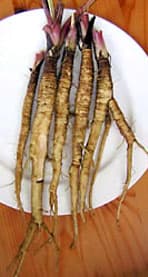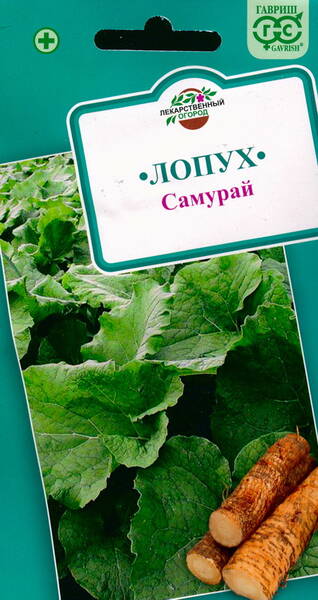For the treatment of kidney diseases, gall bladder and joint diseases. Very useful for diabetics.
Asteraceae family. Biennial herbaceous plant with a branched tap root. In the first year of life it produces a succulent root (root vegetable) and a rosette of leaves. In the second year, the plant blooms, forming a branched shoot 60-80 cm high. The weight of the root crop is 200-600 g.
Vegetable burdock is cultivated to produce roots and young leaves, which are used in cooking and as a medicine. Burdock roots contain the polysaccharide inulin, large amounts of iron and other active substances. By infusing them in olive oil, burdock oil is obtained.
The agricultural technology for growing vegetable burdock is simple: the seeds are sown directly into the soil to a depth of 1-2 cm.
Time for sowing seeds: April-May or before winter.
First, the bed is dug deeply and rotted manure and wood ash are added. On heavy soil, it is necessary to add additional river sand and well-aerated peat. Until seedlings emerge, the soil must be kept moist. Until the leaves reach a height of 20 cm, the bed is weeded several times, and then the plant itself suppresses all weeds.
* As a valuable plant, burdock is widely cultivated in the USA, France, China, and Japan. In cultivation, it is grown on moist soils through seedlings or by sowing seeds in the ground. At the same time, the roots, young leaves, and petioles of the vegetable burdock are used as food. The pulp of burdock root vegetables is grayish-white, juicy, sweetish and pleasant to the taste. They can replace parsnips, parsley and even... carrots.
The most famous of them is the Russian variety of vegetable burdock "Samurai".
In the first year, this plant forms a powerful rosette of leaves and a juicy root crop of almost cylindrical shape, branched at the bottom.
It looks like a large carrot, 30-35 cm long, up to 5 cm in diameter and weighing up to 200-600 g, covered with dark gray bark, with white and dense flesh.

Great Burdock. Bot. syn.: Lappa major Gaertn., Lappa officinalis All.
* Vegetable burdock, including wild burdock, is extremely useful in home cooking.
It is cultivated for its tender salad leaves, petioles and sweet root vegetables. They will be the most delicious in the first year if you remove them at the end of September along with late carrots.
If you left some of the plants for the spring, then they must be removed before the flower stalks emerge, no later than the end of May. A few root vegetables can be left for seed if there are no wild relatives nearby.
Salads are prepared from young burdock leaves. For salad or vinaigrette, use boiled sweet roots and peeled, boiled petioles. Fresh leaves and petioles are added to green cabbage soup. Fried or baked burdock roots are especially tasty.
To make coffee, burdock roots must be crushed, dried, roasted in the oven until brown, and ground in a coffee grinder. To prepare the drink, add 2 teaspoons of powder and sugar to taste to 1 glass of boiling water.
You can make jam from burdock roots without... sugar. To prepare it, pour vinegar essence into water and bring to a boil. Then put the burdock roots, minced in a meat grinder, into boiling water and cook for 2 hours. Both leaves and roots of burdock can be used to prepare excellent preparations for the winter.
Both root vegetables and burdock leaves have a rich chemical composition. Young burdock leaves contain up to 300 mg% of vitamin C, which is 6 times more than in the universally revered lemon, and the same amount as the vegetable champion - bell peppers - and many, many times more than in beets, potatoes, carrots, zucchini and other vegetables.
And burdock roots contain a large amount of the polysaccharide inulin (more than 35%), which determines the sweetish taste of the root. Inulin in the human intestine is broken down into fructose molecules, which are completely safe for patients with diabetes.
For medicinal purposes, the roots of plants in the first year of life are used, when they are juicy and fleshy. Both fresh leaves and dry leaves soaked in warm water have strong antibacterial properties. They are used as a wound healing agent and applied to burns, wounds, cuts, abrasions, inflammation and swollen areas of the skin.












